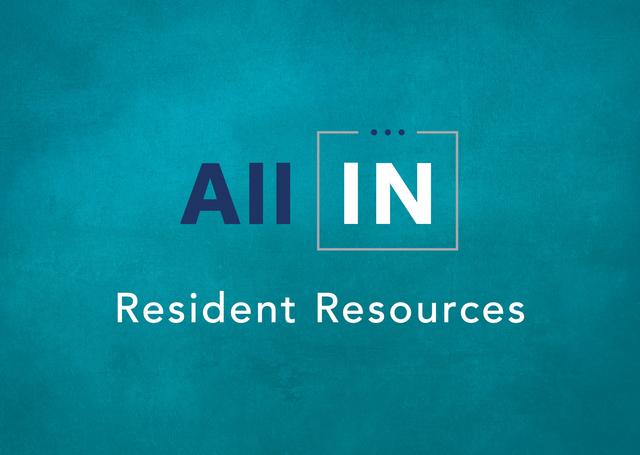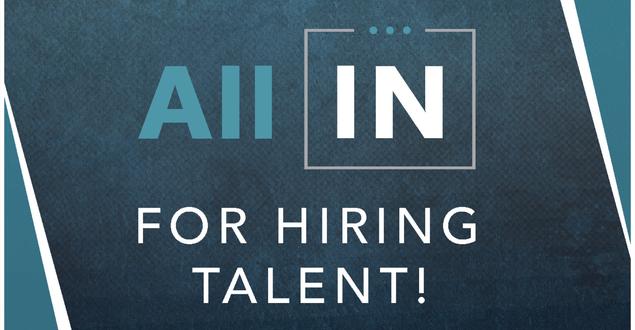
COVID-19 has impacted nearly every aspect of the local and global economy. This page was compiled of internal and external sources to provide insight about the pandemic as well as its impact on capital markets, rent collection, construction and architecture, operations, public policy, among other impacts.
Essential Employment
As part of our work to support residents and the economic recovery, Dominium is adding to its ALL IN campaign around the COVID-19 pandemic by pledging to increase employment by 10%. Dominium is ALL IN for hiring talent and has a number of opportunities available.
Scholarship Program
Dominium named its first class of Dominium Scholars. 80 residents and 20 employees (or their dependents) were awarded $5000 scholarships to further their education in college, vocational or certificate programs. The program—called Opportunity’s Front Door—is a new program of the Dominium Foundation and seeks to bridge the all too frequent gap between talent and opportunity.
Rent Collections—Significant Deterioration in Collections Began in September
Our expectations for a rent collection slow down were a month delayed but arrived in earnest in September. The decline is noticeable and, furthermore, is seen across the portfolio with little variation in geography, type of property, or relative rent advantage to market rents. This reality is a marked difference from previous months where we did see markets with high rent advantage over market rents with higher collections than markets with lower rent advantage, indicating widespread distress in residents’ financial health. We are also seeing distress in collections at senior properties as well.
As of September 30, we have collected 88.6% of resident charges for the month.
- Cumulative receipts are down (4%) compared to August
- Cumulative receipts are down (3%) compared to July
In terms of types of properties or receipts:
- Resident receipts are at 89%, which is down (4%) compared to August through the 30th and down (2%) compared to July through the 30th. They are down (2%) compared to October 30th, 2019, the most recent month in which the 1st fell on a Tuesday.
- Subsidy receipts are at 89%, which is down (4%) compared to August through the 30th and flat compared to July through the 30th. They are down (5%) compared to October 30th.
- Senior total receipts are 95%, which is down (5%) compared to August through the 30th and down (2%) compared to July through the 30th. They are up 2% compared to October 30th.
- Family total receipts are 87%, which is down (4%) compared to August through the 30th and down (2%) compared to July through the 30th. They are down (3%) compared to October 30th.

The chart below shows the distribution of properties on their collection performance in September through the 30th. Out of the 207 properties, 23 have collected less than 70% of September charges representing $0.4M remaining to collect while 47 properties have collected over 96% representing $0.1M remaining to collect.

The lowest collection category is primarily made up of Section 8 properties which are impacted by timing with changes between resident and subsidy owed charges. The below distribution excludes these properties and follows the expected trends.

Previous Dominium Rent Reports can be found below.
Housing & Employment News
U.S. renters will owe up to $34 billion in past-due rent by January, increasing eviction filings and imposing punishing financial hardship on millions in just a few months, according to the National Council of State Housing Agencies (NCSHA). The report, produced by Stout, Risius Ross LLC, estimates roughly 10 – 14 million renter households — home to 23 – 34 million renters — were behind on their rent by a total of roughly $12 – $17 billion as of September 14.
NMHC’s Rent Payment Tracker highlights the ongoing issues with rent collections during the COVID-19 pandemic. Only 90.1% of apartment households were able to pay full or partial rent by September 20th, which is a 1.7% drop since the same time last year. NMHC President, Doug Bibby, states that this only highlights “the real-world impact of lawmakers failing in their responsibilities to their constituents.” He continues by emphasizing that action on the part of lawmakers and the Trump administration is necessary in “mitigating, to some degree, the negative consequences of the nationwide moratorium which jeopardizes the stability of the nation’s housing finance system.”
The National Apartment Association (NAA) published an article discussing how the federal eviction moratorium has put additional stress on the apartment industry. NAA is part of a coalition asking Congress to pass federal rental assistance program to help both housing providers and residents affected by COVID-19. The CDC moratorium allows states with stricter provisions to be exempt, but this has caused come confusion on a state by state basis. NAA is pushing the federal government for more guidance on the CDC order as well as more assistance for those affected by the eviction restrictions.
As eviction moratoriums are put in place to protect renters through the end of 2020, smaller landlords may experience their own unemployment as they struggle to cover mortgages, utilities, property taxes, etc. due to loss of income from collections. Many smaller landlords have fewer resources to help withstand lack of rental income. Rental Housing Finance Survey found that over 40% of residential units are owned by individual investors. Brookings contends that federal rental assistance is crucial to not only protecting the housing of tenants, but also smaller landlords.
Freddie Mac released their August Securitization Forbearance Report highlighting some items that occurred in August in the multifamily space. There was a net decrease of 25 loans in forbearance in the month of August, which is the first decline since the implementation of the forbearance program in March. NMHC noted that rent payments slowed in August, with 94.5% of renters making full or partial payments, compared to 95.7% in July.
Fannie Mae hosted a call about their Economic and Housing Outlook this past week. The virus is not a standard economic element making it hard to model the economic recovery. The call looked at general economic trends, monetary and fiscal policy, multifamily market outlook, and the single-family mortgage market. Some key takeaways include September 2020 collections are down 2.5% from year over year, and nationally 28% of properties are offering concessions.
Economic News
The Wall Street Journal highlights how the pandemic has disrupted many millennials’ career and financial goals forcing many to only plan one month ahead. As the pandemic continues, it feels like the goals of the millennial generation have been “put on hold as [they] wrestle with how to reconcile financial and career goals with the ever-evolving pandemic timeline.”
SunTrust sent their weekly Interest Rate Derivatives Market Update and highlights that the FOMC is ready to accept a higher inflation to an average of 2% over time. Pfizer’s CEO said that they will have a vaccine ready by the end of 2020. China’s consumer spending has increased as well as its industrial production signaling more rebound for their economy.
Key Bank held a call titled, “Back to the Office or Back to the Future,” that discussed the current conditions of the financial markets as well as the outlook for commercial real estate in the time of COVID-19. They note that the work from home experiment has been a success and many employers will continue to allow working from home post-COVID in some capacity. Key Bank notes that the future of the office market will depend on employee behaviors. [Internal Notes]
The Economic Club of Minnesota held a webinar about the Future of Work and Business. The pandemic accelerated remote work, tele-medicine, and ecommerce, but also has highlighted economic inequality with access to reliable internet and the ability to purchase equipment. Jack Uldrich noted that there are three differences working from home from working in an office, workers spend less time commuting which means more time spent with family, the second largest expense for many companies is their real estate, and lastly fewer people driving and flying for work will positively impact the environment.
TCF hosted an Economic Outlook and Insights webinar with Jason Sasanfar, the Executive FVP, Deputy Treasurer and Chief Investment Officer. The discussion focused on the structural forces driving the economy, the impacts of current events, how the 2020 predictions unfolded, and the outlook for 2021. Consumer activity is still down and only about half the jobs lost in the first two months of the pandemic have been recovered. [Internal Notes and Slides]
Middle-class family finances are being decimated by the pandemic, with many families feeling as though they will not be able to “claw [their] way out of this situation.” Non-housing debt has risen 33% over the last 12 years, which include student loans, credit card, and auto loans. College-educated families are “getting slammed” according to Anthony Carnevale, director of the Georgetown University Center on Education and the Workforce.
US consumer spending declined in August due to the ending of additional unemployment benefits from the federal government, proving that an economic recovery is losing momentum. Nearly 30 million people are on unemployment benefits. The Federal Reserve said that the pandemic “will continue to weigh on economic activity… and poses considerable risks to the economic outlook over the medium term.”
Pandemic News
Flu shots can help alleviate some of the burden on the health care system by helping curb how many severe flu patients need emergency medical attention. If people get the flu after being immunized, it may be less severe. Experts believe that those more susceptible to the flu may also be more susceptible to contracting COVID and for it to become serious. Normally, it is recommended to get a flu shot in October so that it lasts the whole flu season, but since we’re in the midst of a pandemic, September may be better.
Younger Americans have been more likely than older Americans to spread the Coronavirus, largely due to their higher likelihood of working lower paid in-person service jobs like retail or attending in person classes. Coronavirus risk is strongly correlated with income, which influences the ability of a person to socially distance, with lower wage earners being less able to work from home.
Various conspiracy theories and misinformation about the origin of the Coronavirus have been widely circulated on the internet. National Geographic discusses how a combination of factors, including the psychological dynamics of what gets shared on social media and the encouraging of “preprints” of not-yet per reviewed research on the Coronavirus has led to politically motivated misinformation about the virus taking hold.
A new report from the CDC found that a large number of US children dying of Coronavirus are children of color. Examining COVID case data from February through the end of July of people under the age of 21, researchers found more than 390,000 deaths and 121 deaths. Of the 121 deaths, 78% of them were children of color (45% Hispanic, 29% Black, 4% non-Hispanic American Indian or Alaska Native). This disparity is also reflected in the deaths of adults, as twice as many people of color under the age of 65 have died due to Coronavirus compared to that of white Americans.
The US still has an N-95 mask shortage leaving many wondering why the world’s richest country still can’t meet the demand. Many nurses and doctors are still reusing their N-95 masks for weeks and months despite their single-use design. Supply chain managers are now trying to determine how to keep their employees safe. This article shares a timeline of events related to N-95 ordering following the beginning of the pandemic and gives a breakdown about how N-95 masks work to protect wearers.
As soon as the first COVID-19 vaccine is authorized by the FDA, the US plans to distribute it immediately. Vaccines are already being manufactured for distribution, as long as the trials prove to be safe. The US government has also said that they will track who has received the vaccine in a database, so if two shots are required, they can help make sure they receive their second shot.
A vaccine for children may not be available until the fall of 2021. The vaccines that are being discussed now are for adults and could be available by next summer. The clinical trials for an adult vaccine are already in the advanced stages, but they have not been tested for safety to be used on children. This is causing some concern that a vaccine for kids may not be available before the next school year.
A Maine wedding in early August is now linked to 175 reported cases and 7 deaths. None of the 7 deaths attended the wedding. This isn’t the only superspreader event that contact tracers are researching, as cases continue to be linked to the Sturgis motorcycle rally and a choir practice in Washington. The spread to non-attendees can increase rapidly if attendees live in areas that do not enforce social distancing and mask-wearing.
The September 25th episode of the Osterholm Update: COVID-19 discusses the status of vaccine development, the CDC, COVID-19 in the US as the death toll surpasses 200,000, and advice for pet owners.

IHME has changed their daily infections and testing to project the trajectory of infections based on easing mandates and closures and universal mask wearing.
Other Interesting & Helpful Resources
The movie theater industry has been hit hard by the pandemic. Hoping to revive the theater industry, blockbuster “Tenet” opened in theaters a few weeks ago following months of theater closures, but the movie’s lackluster performance proved that Americans are not ready to return to the theater. Due to poor performance, other Hollywood blockbusters are postponing their release dates, like “Wonder Woman 1984.” It is unclear when moviegoers will feel comfortable to return to the indoor theaters.
Gym owners are trying to lure back their clients saying that it is safe to work out, but experts say that the data used to illustrate gym safety is flawed. The study had gym owners self-report the number of cases linked to their studios from May through early August and found a “nominal” number of cases were reported compared to the number of gym attendees (1,155 positive cases compared to 49 million visits). Whereas, experts say that the data is “likely to be incomplete and biased in the direction of underestimating the prevalence of COVID transmission at health clubs.”
The NFL fined three head coaches $100,000 for not wearing their face masks on the sidelines, which is a requirement as part of the league’s COVID precautions. Their respective teams will also be fined $250,000 for the infraction. Seattle’s Pete Carroll, San Francisco’s Kyle Shanahan and Denver’s Vic Fangio have been fined.
State-by-State Actions
- Schools: Education Week
- Reopening Status: The New York Times
- Construction Limits: Architect Magazine

Resident Resources
National Low Income Housing Coalition put together a State and Local Rental Assistance guide for COVID-19 Emergency Rental Assistance Programs around the country.
Fannie Mae put together a “Here to Help Renters” resource guide. It includes tips for talking to your landlord, top things to know, and options for those in need of financial assistance. Other resources are linked to HUD, CARES Act, and state and local resources.
Freddie Mac offers a Renter Helpline, which provides counseling for renters on budgeting, credit improvement and debt management. The attached flyer is available in multiple languages.
HUD has put together a guide and FAQ for Renters during the pandemic.
The United Way is assisting residents in Minnesota with COVID housing assistance program. Those needing support can call 211 or toll free at 1-800-543-7709.
Family Housing Fund has put together resources for households impacted by COVID-19, ranging from legal help, utilities, food, unemployment insurance and more.
Housing Link has provided tips for emergency assistance in the Twin Cities with contact information by county.
National Alliance on Mental Illness Minnesota also has a list for families of financial and housing resources. You can also search for reduced cost services by zip code on their website.
Dominium Resident Resources by property
Information on filing for unemployment

Communications
We hope that our friends and partners in affordable housing find this information helpful and will send information our way as well. A collection of previous updates can be found below.
Impact Updates
#1 - April 1, 2020 | #2 - April 2, 2020 | #3 - April 3, 2020 | #4 - April 4, 2020 | #5 - April 6, 2020
#6 - April 7, 2020 | #7 - April 8, 2020 | #8 - April 9, 2020 | #9 - April 10, 2020 | #10 - April 14, 2020
#11 - April 21, 2020 | #12 - April 28, 2020 | #13 - May 5, 2020 | #14 - May 8, 2020 | #15 - May 13, 2020
#16 - May 15, 2020 | #17 - May 19, 2020 | #18 - May 22, 2020 | #19 - May 26, 2020 | #20 - May 29, 2020
#21 - June 2, 2020 | #22 - June 9, 2020 | #23 - June 17, 2020 | #24 - June 23, 2020 | #25 - July 1, 2020
#26 - July 9, 2020 | #27 - July 22, 2020 | #28 - August 14, 2020 | #29 - August 25, 2020
#30 - September 1, 2020 | #31 - September 16, 2020 | #32 - October 1, 2020
![]()


